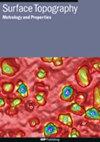不锈钢基底表面沉积铜的分子动力学模拟和分析
IF 2
3区 材料科学
Q2 ENGINEERING, MECHANICAL
引用次数: 0
摘要
铜(Cu)被广泛应用于集成电路和微型设备中,由于其电阻率低、电迁移性能强且价格低廉,有可能取代铝合金。然而,影响微米和纳米尺度器件性能的一个重要因素是沉积物的表面粗糙度。LAMMPS 软件用于模拟不锈钢基底理想状态下的沉积 Cu。分析了铜在表面的沉积过程和变形行为以及沉积表面的粗糙度。以 Cu 原子的沉积过程为对象,研究了不同原子序数、不同温度、不同速度和不同高度对沉积物表面粗糙度的影响。通过分析沉积速度的原子结构组成,以及径向分布函数,揭示其微观作用机理。理论沉积和分析结果表明,表面粗糙度随沉积原子数的增加而增加,随基底温度的升高而降低。随着速度的增加,表面粗糙度先是减小,然后经过一些波动后保持在一个特定的水平上。此外,随着沉积高度的增加,表面粗糙度也会降低。各种成分与沉积表面粗糙度之间存在非线性关系。在沉积过程中,可以通过优化沉积原子、基底温度、沉积速度和沉积高度等沉积参数来提高沉积物的表面质量。本文章由计算机程序翻译,如有差异,请以英文原文为准。
Molecular dynamics simulations and analyzation of Cu deposited on stainless steel substrate surfaces
Copper (Cu) is used in integrated circuits and microdevices and has the potential to replace aluminum alloys due to its low resistivity, strong electromigration properties, and affordability. However, a significant factor that influences the performance of devices at the micro and nano scales is the surface roughness of the deposits. LAMMPS software is employed to simulate the deposition Cu on an ideal state for a stainless-steel substrate. The deposition process and deformation behavior of Cu on the surface and the roughness of the deposition surface are analyzed. Taking the deposition process of Cu atoms as an object, the effects of different atomic numbers, different temperatures, different velocities, and different heights on the surface roughness of the deposits were investigated. The atomic structure composition of the deposition velocity is analyzed, and the radial distribution function is analyzed to reveal the microscopic mechanism of action. The results of the theoretical deposition and analysis show that the surface roughness increases with the number of atoms deposited and decreases with increasing substrate temperature. The surface roughness first decreases and then, after some fluctuation, stays constant at a particular level with increasing velocity. Additionally, as the deposition height increases, the surface roughness reduces. There is a nonlinear relationship between the various components and the deposited surface roughness. The surface quality of deposits can be improved during the deposition process by optimizing the deposition parameters of deposition atoms, substrate temperature, deposition velocity, and deposition height.
求助全文
通过发布文献求助,成功后即可免费获取论文全文。
去求助
来源期刊

Surface Topography: Metrology and Properties
Materials Science-Materials Chemistry
CiteScore
4.10
自引率
22.20%
发文量
183
期刊介绍:
An international forum for academics, industrialists and engineers to publish the latest research in surface topography measurement and characterisation, instrumentation development and the properties of surfaces.
 求助内容:
求助内容: 应助结果提醒方式:
应助结果提醒方式:


